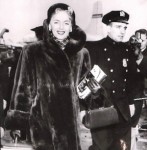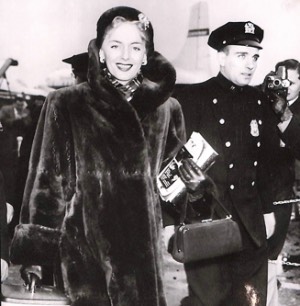
 Christine Comes Home from Denmark.
Christine Comes Home from Denmark.
Although the history of transgender people covers several centuries, those preceding the 20th-century lack recognition; they are considered “deviants“, “alienated“. Gradually, terms such as “uranians“, or “sexual intermediaries“ appear, but also the notion of “third sex“ developed by Karl-Heinrich Ulrichs, a German pioneer of sexology, A forerunner of homosexual activism and LGBT emancipation movements.
Transsexualism as a concept was born in Germany during the 1910s and 1920s, in the wake of the early sexology. This notion was gradually internationalized in the 1930s and 1940s with the first operations and sexual reassignments, to finally obtain a progressive societal recognition in symbiosis with the sexual revolution of the 1960s. Consequently, the second half of the 20th century changed the balance between awareness of the cause and recognition of the first communities. Finally, during the 1990s transidentity was depsychiatrised which led to its legal recognition and the creation of militant associations.
Christine Jorgensen is known as the first transsexual to have mediated her transition. Born “George Jorgensen“ on May 30, 1926, she died on May 3, 1989. After growing up in a modest family in the Bronx, she was incorporated into the United States Army at the age of nineteen, an environment where virility was promoted and where she felt isolated. When he went back to school, Jorgensen became interested in his difference and inquired about a possible sexual reassignment (aïdoïopoiesis), meaning “all surgical procedures that reshape the male genitals to make them look as similar as possible to the female genitals.”
In Copenhagen, she met Christian Hamburger, a doctor specializing in these surgeries, and underwent a castration of the testicles and then, a year later, an ablation of the penis. She is also treated with hormonal therapy, a treatment initially used against certain cancers (such as prostate, breasts). Targeted sex hormones are given to transgender people in order to develop or reduce secondary sexual characteristics (hair, breast, muscles, etc.). Thanks to this hormone therapy, Jorgensen develops the first female physical characters. The combination of hormonal therapy and surgeries (1951-1952) is a real success, unlike other operations, such as that of Lili Elbe (in 1930) to which she does not survive, this is a decisive moment marking the improvement of the interventions.
Her fame resounded upon her return to New York in February 1953, when the media rushed to her. The New York Daily News writes: «An ex-GI becomes a lovely blonde». Even if she considers this media enthusiasm excessive, she uses her story as a springboard to become famous. Yet, if Jorgensen said she felt overwhelmed, she, in advance, tried to control the zeal of the press towards her; while she had not yet returned to the United States, she sold the rights to her personal story to American Weekly Magazine for $20,000. From then on, the press seized all the events of her daily life: driving tests, outings, moves, first stage performances… If some consider this character as a modern pillar of the moral revolution, others consider her as a monster and an oddity. In an interview with Newsday in 1979, she said: “I regretted, at first, that the press took it over and made my life an open book. But the advertising, too, wasn’t all bad. It made me gain a lot of money.” If, during the 1950s and 1960s, she easily earned her living thanks to talk shows, conferences and as a stage actress in clubs, her fame gradually faded, and she retired to Long Island for a more modest life.
As a transgender woman, she had some objections, including legal ones, when she wanted to marry Howard J. Knox because Jorgensen’s birth certificate still makes her a man. Finally, it was during the 1970s and 1980s that her activism grew when she visited universities to talk about her experience. In 1989, she said she gave the sexual revolution “a kick in the butt to make it go faster“.
Jorgensen’s story challenges the binary of genres on which the scientific world had agreed. In the 1990s, there was a redefinition of gender by doctors with the term “psychological sex”: that which may not be equivalent to its biological sex.
Read more in the dictionary : Caster Semenya
Read the paper in French : Jorgensen
Références :
Maxime Foerster, Elle ou lui ? Histoire des transsexuels en France, Paris, La Musardine, 2012.
Ilana Löwy, « Intersexe et transsexualités : Les technologies de la médecine et la séparation du sexe biologique du sexe social », Cahiers du Genre, 2003/1 (n° 34), p. 81-104.
To quote this paper : Emma Pineau, "Christine Jorgensen", in Hervé Guillemain (ed.), DicoPolHiS, Le Mans Université, 2022.